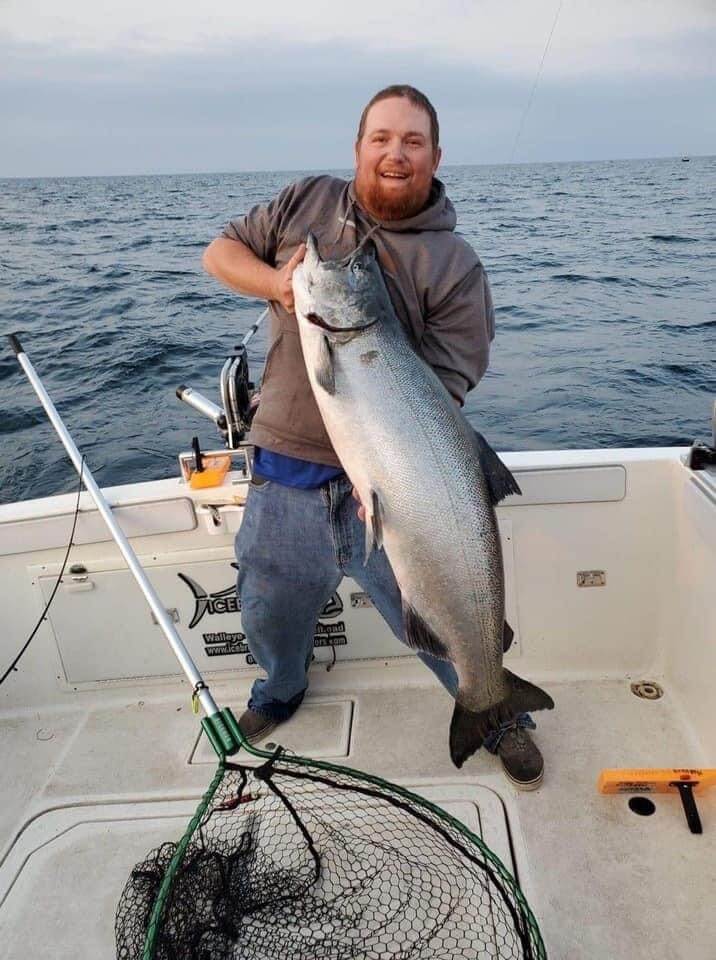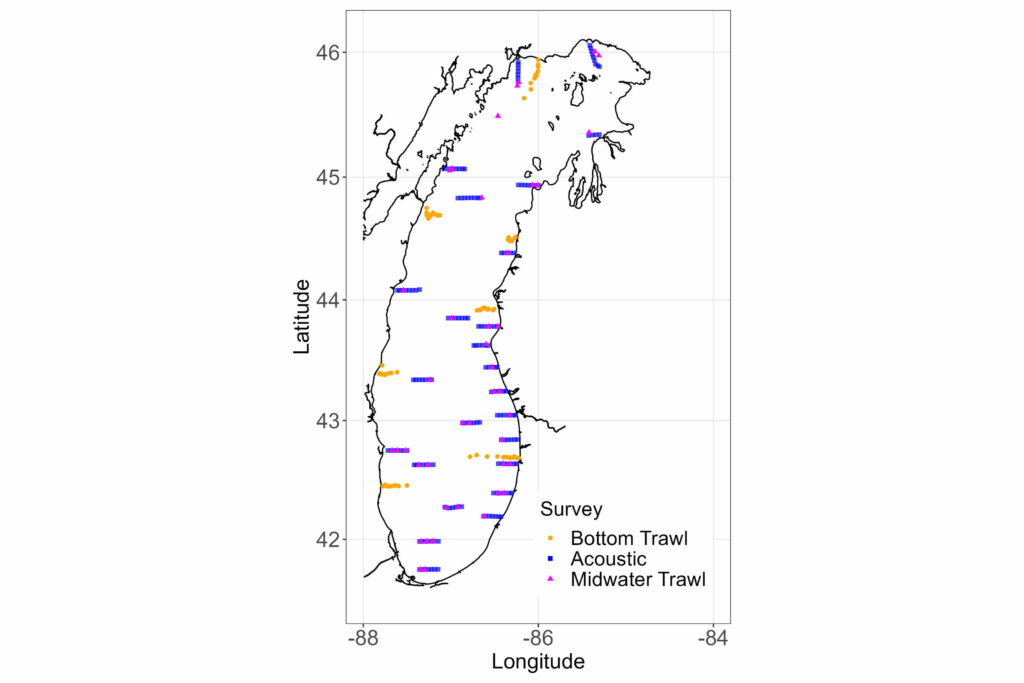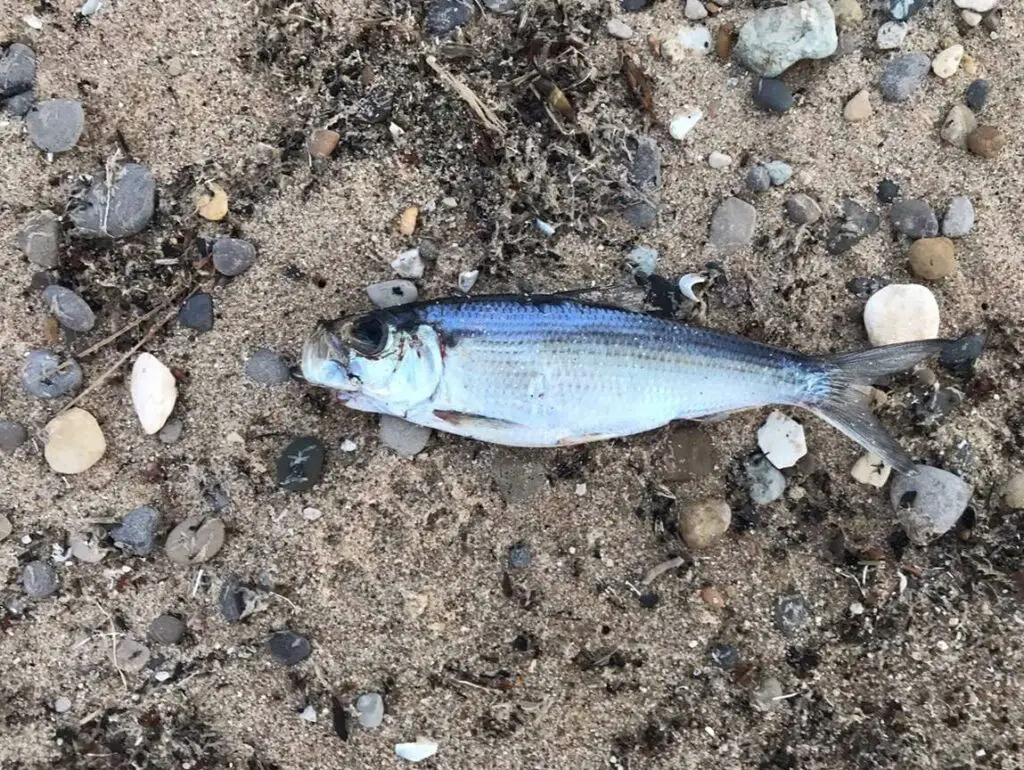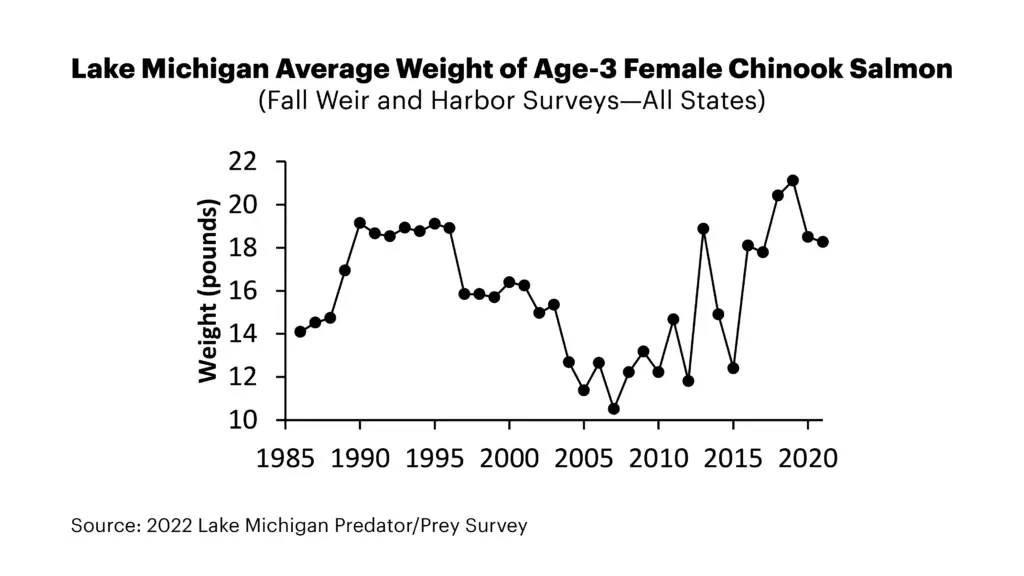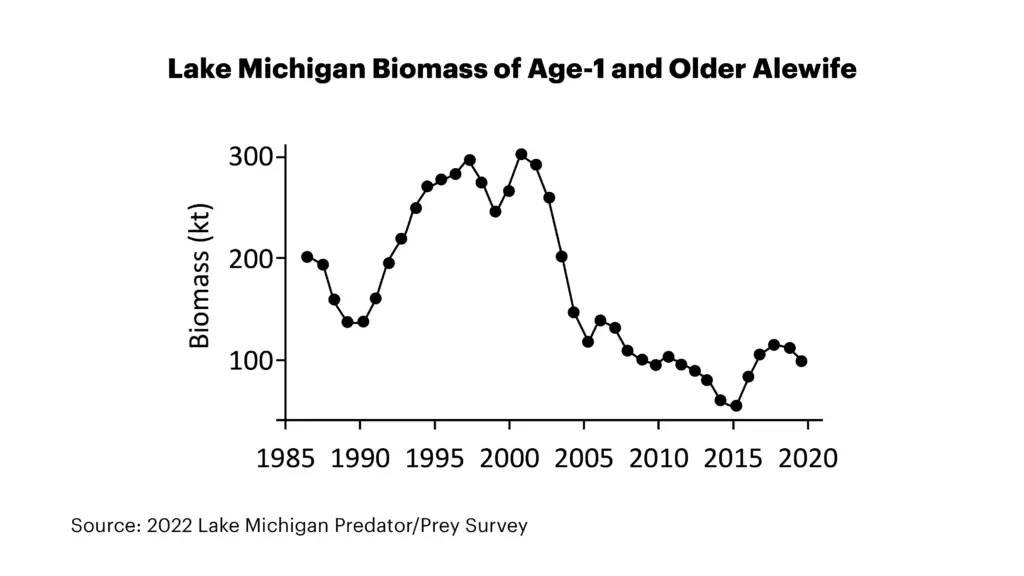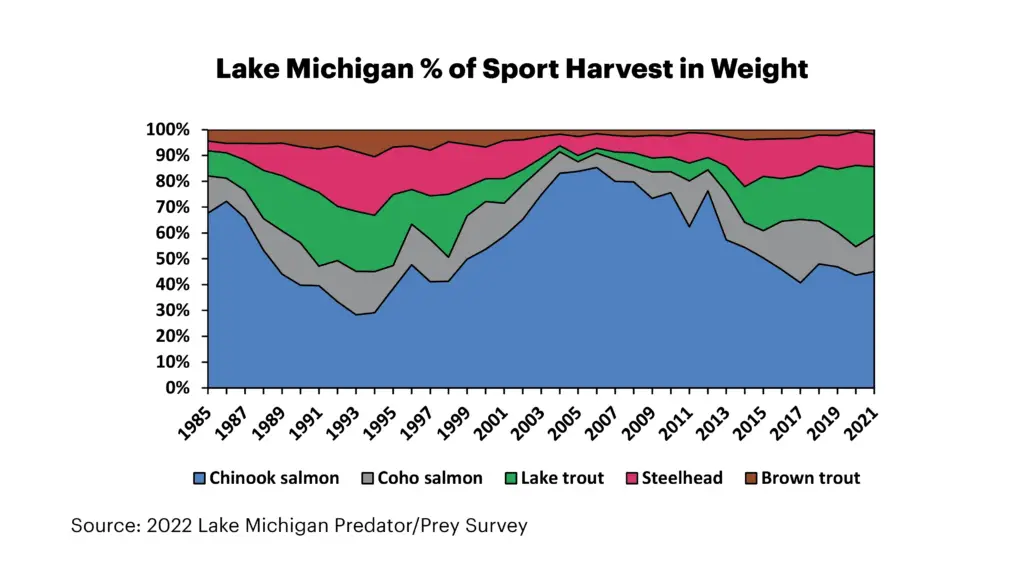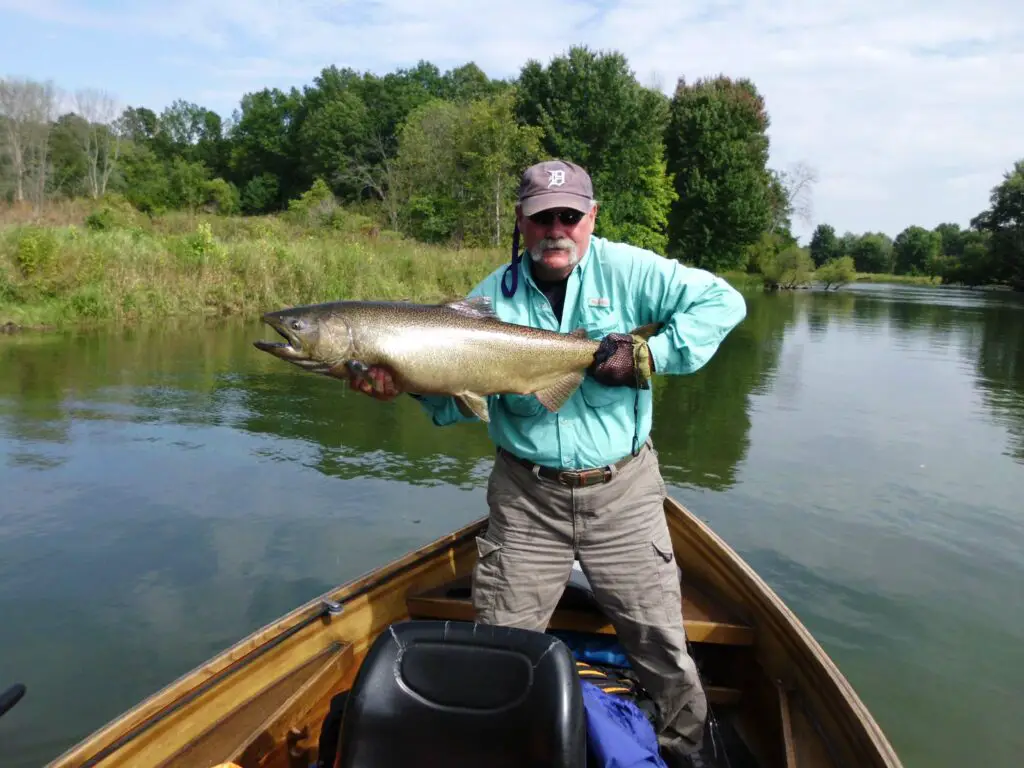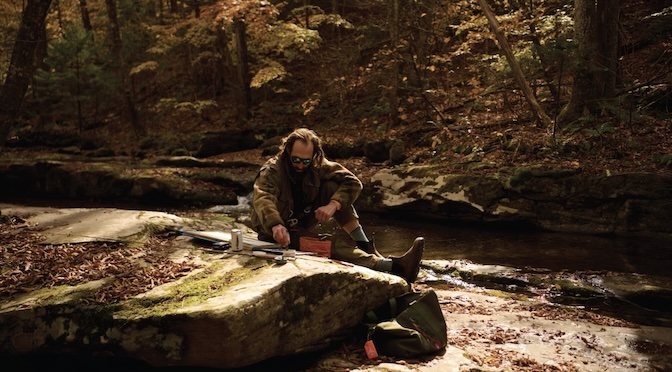Last updated on May 22nd, 2023.
After decades of fish stocking decreases to balance the alewife and Chinook salmon populations, …
the Michigan Department of Natural Resources (DNR) is seeing good indicators that a modest stocking increase is warranted in Lake Michigan. After hosting a virtual meeting on September 19, 2022 to receive public feedback, the DNR is moving ahead with 2023 plans to increase Chinook salmon stocking in Lake Michigan. “We have seen several years of good Chinook salmon growth and have a slight increase in the alewife biomass, or abundance of those fish,” said Jay Wesley, the DNR’s Lake Michigan basin coordinator. “Although the alewife biomass is a fraction of what it was historically, we have a good 2021-year class and have seen up to six-year classes of alewives in our fisheries surveys which means there are up to six different age groups in the current population of alewife.”
A “year class” refers to all of the fish of any species hatched, either through natural reproduction or through fish-rearing efforts, during that year’s spawning period.
Wesley said that a recently run predator-prey model suggests that Lake Michigan has a good ratio of Chinook to alewife biomass, which is one of many indicators used to inform stocking decisions.
“The proposed 54% increase from 650,000 to one million spring fingerlings is a modest increase compared to the estimated 4.5 million wild Chinook salmon in Lake Michigan,” said Wesley. “It will allow us to increase numbers at sites like Charlevoix that contribute to the entire lake fishery and reinstate stocking sites like Ludington State Park and Fairport.” Fairport is located south of Manistique in Michigan’s U.P.
The Michigan DNR has stocked 650,000 Chinook fingerlings annually through 2022 and will now stock one million salmon annually until a change is warranted.
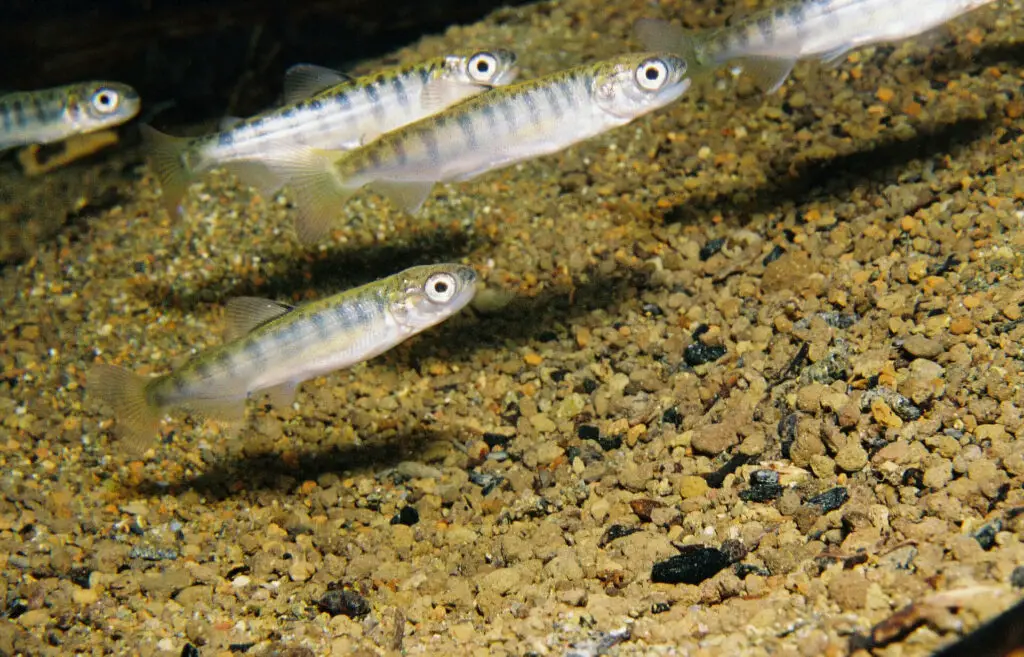
Chinook Stocking Locations
Chinook salmon fingerlings are stocked at six months old and are between 3.5 and 4.0 inches long.
“We primarily stock near river mouths in acclimation pens,” said Wesley. “We currently stock the Manistique, Medusa (Charlevoix), Boardman (Traverse City), Muskegon, Grand, Kalamazoo (Saugatuck), Black (South Haven), and St. Joseph rivers.”
Chinook fingerlings will be also be released in rivers that produce the broodstock (where eggs are harvested) like the Little Manistee River. They are also stocked in rivers that have no or low numbers of natural reproduction, in rivers that have good access (fish ladders/boating/piers), and rivers or ports that have high fishing activity.“ Our main objective for the stocking program is to create an open lake fishery for Chinook salmon,” said Wesley. “A secondary objective is to create river fisheries. We try not to stock rivers with good spawning habitat as those rivers tend to be self-sustaining and have wild or natural runs of Chinook salmon. These natural reproducing rivers include the White, Pentwater, Pere Marquette, Manistee, and Betsie rivers. These stocked Chinooks are able to return to rivers and naturally spawn. Reproduction success is based on the quality of the spawning habitat and river/stream conditions.”
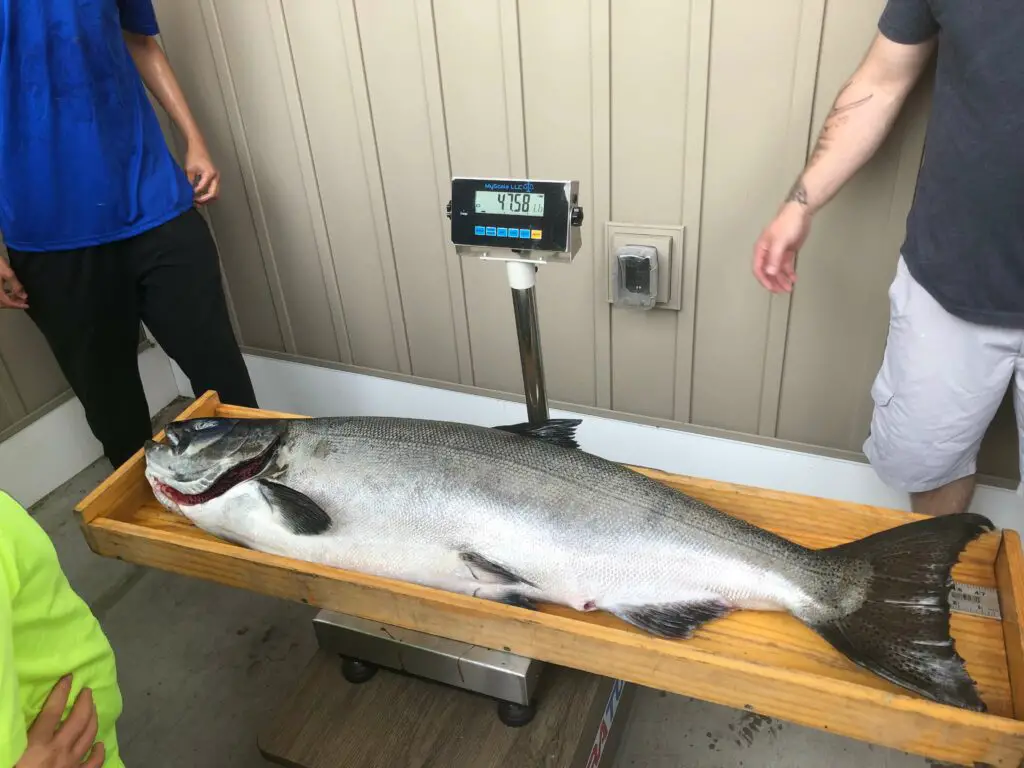
Maintaining Predator and Prey Balance is the Goal
Maintaining balance between predator and prey populations is critical for successful fisheries management. In Lake Michigan, several top predators contribute to important sport fisheries including native lake trout along with non-native Chinook salmon, coho salmon, rainbow trout and brown trout. These predators are sustained through both stocking and wild production. Stocking level adjustments to balance overall predator populations with available forage is a major component of ongoing Michigan DNR fisheries management efforts.
The Predator/Prey Ratio Analysis for Chinook salmon and alewives in Lake Michigan was initiated in 2016 to help guide Great Lakes fisheries management decisions for stocking and is conducted annually. Alewives are a small prey fish that reach two to nine inches in length and were introduced to Lakes Michigan and Huron as an invasive species in the 1950s. Because of the decline of native species like lake whitefish and lake herring due to overfishing and habitat degradation at the time, the door was open for alewives to proliferate.
The Predator/Prey Study is sponsored by the Lake Michigan Salmonid Working Group which is comprised of the lllinois DNR, Indiana DNR, Michigan DNR, Wisconsin DNR, U.S. Fish & Wildlife Service, U.S. Geological Survey, Michigan State University, Little River Band of Odawa Indians, Great Lakes Fishery Commission, and Chippewa-Ottawa Resource Authority.
Predators and Prey Population Fluctuations
Lake Michigan historically has experienced wide fluctuations in populations of fish predators and prey, due largely to fishing exploitation, changes in habitat quality, changes in predator stocking rates, disease outbreaks, and invasive species. Notably, lake trout populations collapsed during the 1950s due to a combination of predation by invasive sea lamprey and overfishing. Subsequently (without a top predator), invasive alewife populations greatly expanded. Sea lamprey control efforts were implemented in the late 1960s and, combined with abundant alewife forage, created opportunity to successfully stock top predators.
Fisheries managers began stocking lake trout along with Chinook salmon, coho salmon, rainbow trout and brown trout to utilize available forage and create diverse fishing opportunities. Chinook salmon were first introduced to Lake Michigan in 1967 specifically to help control the alewife population. These stocking efforts continue today, and several past stocking level adjustments have been implemented to help sustain a balanced and diverse fishery. Chinook salmon and alewives are important components of Lake Michigan’s current ecosystem and fishery but maintaining a predator-prey balance is challenging.
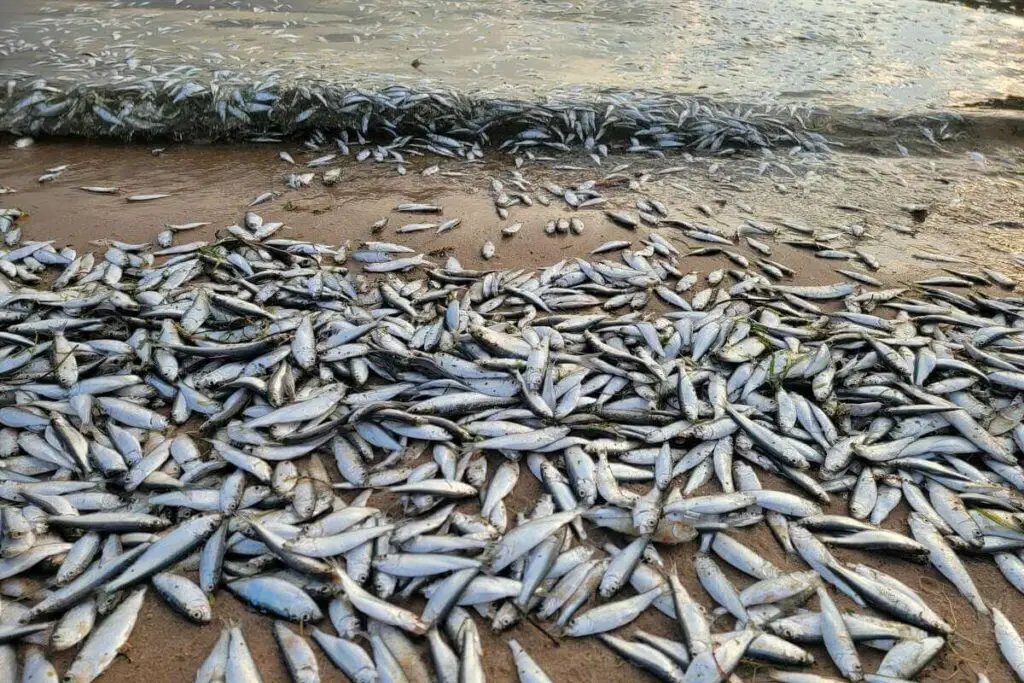
In Lake Michigan, Chinook salmon are a dominant predator whose diet consists mostly of alewives, an important mid-water prey fish. Chinook salmon and alewives together support an important recreational fishery, and Chinooks are a preferred and targeted species for many recreational and charter anglers. During the late 1980s to early 1990s, this Chinook salmon population and fishery declined (despite high stocking levels) due to mortality from bacterial kidney disease. More recently, predator/prey and energy dynamics in Lake Michigan have changed due to bottom-up ecosystem effects (by invasive mussels) and top-down predation effects (by stocked and wild predators). Invasive filter-feeding mussels are effective consumers of microscopic plants, which serve as the base of the food web. Naturally produced Chinook salmon are common and, in combination with stocked Chinook salmon and other trout and salmon species, exert high predation pressure on alewives and other prey.
Alewife Salmon Sampling Techniques and Locations
Alewives are sampled during summer bottom mid-depth trawl surveys which feature netting the bait fish using a large net behind boats in addition to acoustic surveys which use sonar. The acoustics surveys collect data continuously along a 30-mile path.
Chinook sampling is done at most ports that anglers return to from lake fishing. DNR creel clerks collect data on all Chinook salmon caught and kept. Charter boats also report their catch. More information is gathered in the Fall for spawning Chinooks at weirs in Wisconsin and Michigan.
September 19, 2022 Meeting Feedback
Public feedback from the September 19, 2022 meeting from anglers, lake charter captains, river guides, Michigan United Conservation Clubs, Trout Unlimited, and lure manufacturers included:
— Increase the stocking of steelhead, coho, brown trout, and lake trout for a more diverse fishery versus Chinook salmon.
— Stock Chinooks in the Platte, lower Elk, Big Manistee, Muskegon, St. Joseph and White rivers along with East Grand Traverse Bay and the Upper Peninsula.
— Stock Atlantic salmon in Lake Michigan which are currently in the St. Mary’s River in Michigan’s U.P.
Regarding the last suggestion, Jay Wesley says Atlantic salmon would do fine in Lake Michigan and are caught periodically in the lake. However, they would directly compete with brown trout, Chinook and coho salmon along with steelhead, and with a lake that is already predator heavy, it does not make sense to bring in a new predator.
2022 Fall Salmon Run Strong Say River Guides
While the focus of the 2023 DNR Lake Michigan Chinook salmon stocking plans is the Lake Michigan sport fishery, many adult Chinooks make their way up Lake Michigan rivers and provide plenty of Fall action for river anglers. Many guides feel a strong Fall salmon season impacts a correspondingly strong steelhead run.
A survey of fly fishing guides who fish major Lake Michigan tributaries found the 2022 Fall chinook salmon run was excellent with above average size fish.
Pere Marquette River: Frank Willets, owner of the Pere Marquette River Lodge, said last Fall was a really good year for Chinooks the entire season, both early and late. “They were as big as they’ve been over the last 18 years,” said Willets. “In fact, our guides have upgraded their rods from 8 and 9 weights to 10 and 12 weight outfits.”
Muskegon River: Tom Werkman, owner of Riverquest Charters, said the 2022 Fall run of Chinook salmon has been above average across the Muskegon, Pere Marquette and White Rivers. He felt last Fall was one of the best years in decades with lots of healthy and wild fish.
Manistee River: John Gouker has guided fly fishing trips on the Manistee for over 20 years. While salmon trips are a very small amount of his guide days with many kings accidentally caught fishing for steelhead, he reports that last year’s run was really solid with fish size and numbers up over the past 10 years.
Michigan U.P. Rivers: Guide Brad Petzke of Rivers North Guide Service has been fishing U.P. Lake Michigan rivers and streams for over 20 years. According to Brad, “there was a fair run of Chinooks in the Manistique River last Fall. The size of the salmon on all of the Lake Michigan tributaries over the past five years has been pretty incredible with very large fish.”
Wisconsin and Indiana to Increase 2023 Chinook Stocking
Indiana DNR will increase Chinook salmon stocked in Lake Michigan by 50,000 starting in spring 2023. The change will increase the annual stocking target for Chinooks from 225,000 to 275,000. Wisconsin DNR is planning to stock 1,300,000 Chinook salmon in 2023 which is an increase of 100,000 over 1,200,000 over the 2020-2022 timeframe.
2022 Predator/Prey Ratio Analysis Draft Available Now
The “Summary of the Predator/Prey Ratio Analysis for Chinook Salmon and Alewife in Lake Michigan” draft report was updated August 18, 2022 with standard results that include data through 2021 and is available here. A final report featuring 2022 data is in progress.

